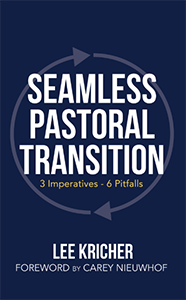How can a seamless pastoral transition lead to a more effective leadership transition? Jessica Anschutz of the Lewis Center staff speaks with Lee Kricher, author of Seamless Pastoral Transition: 3 Imperatives — 6 Pitfalls, about shared leadership, nurturing future leaders, leading with humility, and more.
Listen to this interview, watch the interview video on YouTube, or continue reading.
Jessica Anschutz: Lee, in your book, Seamless Pastoral Transition: 3 imperatives — 6 Pitfalls, you call for church leaders to consider new and creative approaches when it comes to pastoral transitions. What are the characteristics of a seamless pastoral transition?
Lee Kricher: A seamless pastoral transition has no gap between the outgoing and the incoming pastor, but there is an overlap where both serve the congregation. The congregation sees the outgoing pastor in ministry at the same time as they see the incoming pastor in ministry, so it is a seamless transition in that respect.
Jessica Anschutz: How long would you recommend for a seamless pastoral transition for it to be most effective?
Lee Kricher: In the case studies that I did, the time served by both the incoming and outgoing pastor ranged from six weeks to 15 years. So, it really is an extended period or a brief period, depending on what makes sense for the church. The average time for a formal transition seems to be about 12 to 18 months.
Jessica Anschutz: When you think about a seamless pastoral transition, what are the benefits to having both pastors working and serving together at the same time?
Lee Kricher: I grew up in a Lutheran church outside of Philadelphia, and the feeling there was: “This is my church. This will be my church for life. It does not matter if we have a good pastor, a bad pastor, or no pastor. This is just where we are.”
The world has changed, and if a church has positive momentum, if a church is making a positive difference in the community, why put a gap in place between leaders that could jeopardize that momentum? The most powerful outcome is that the momentum and mission of the church is not compromised because of an unnecessary gap between pastors. The congregation also gets to see amazing characteristics in both pastors that are Christlike characteristics. They get to see those modeled before their eyes, which typically does not happen if there are months or years between the outgoing and incoming pastor.
Jessica Anschutz: I am a United Methodist elder and we operate under an itinerant system that does not often leave space for overlapping pastors. What possibilities do you see for seamless pastoral transition in a model like the United Methodist Church?
Lee Kricher: One good thing about the United Methodist model is that you are talking about a matter of months in the typical pastoral transition in a United Methodist Church rather than the years a pastoral transition may take in other denominations. One of the case studies I did was a United Methodist Church. Because the outgoing pastor collaborated with the bishop, the bishop and the outgoing pastor believed that a seamless transition was in the best interest of the church. An assistant pastor was named the successor, approved by the bishop, approved locally within the church and there was a seamless transition. The last day of the outgoing pastor was followed by the first day of the incoming pastor. The church not only maintained its momentum in mission but it accelerated, and the church is still thriving in tremendous ways. So that is a unique option, which of course would still be with the blessing of the bishop.
If nothing else, can the outgoing pastor show support for whoever the incoming pastor is going to be? I know some outgoing pastors will be there for the new pastor’s first service, but sometimes the incoming pastor does not want the outgoing pastor to be there. If done in a right spirit, it can be great for the congregation to see this sense of “I know you’ve loved me as your pastor, and I encourage you to love this new pastor because that person’s entering into this new role with my full support.”
Jessica Anschutz: It is so important that we support one another during the transition. One of the imperatives you highlight is for clergy to share leadership. How do you see shared leadership leading to more effective transitions?
Lee Kricher: I think a great prayer for a pastor is “open my eyes to the leaders who are around me.” I think of King David, whose own father looked at all the leaders in his family and had every single one in mind except for the one who God had in mind.
One pastor said to me, “I would make room for other leaders, if I had any leadership material in my church or on my church staff.” Unfortunately, you do not have a Samuel to open your eyes to who your Davids are. Believe it or not, you do have a David or two or three in which you can invest. To me, sharing leadership is “What can I do to elevate the leaders around me and give them opportunities to gain experience?” as opposed to “I have to do everything that’s on my job description, and nobody else can.”
One pastor said, “I would never share the pulpit. I am going to speak every weekend the rest of my life or the rest of my ministry at least.” And I said, “How about when you go on vacation?” He said, “I leave after the service Sunday, and I get back before the next Sunday.” Well, that’s kind of the opposite of shared leadership. It is “I’ve always got to hold on to this role.”
One of the models I look at in Seamless Pastoral Transition is Moses and his handoff to Joshua. Early in his ministry, Moses was the guy. His father-in-law watched him in operation for a day and said, “What you’re doing is not good.” I often think Moses would have been thinking, “Jethro, I just led the people out of Egypt. I parted the Red Sea. I received the Ten Commandments. Are you sure you want to critique my leadership?” But, he listened to his father-in-law, and he started to raise up other leaders. He started to share leadership not just with judges but with people like Joshua and Caleb, so that when it was time to choose a successor there were ready leaders available.
Jessica Anschutz: You point to the importance of thinking about future leadership not only when it comes to who may succeed you in leadership as the pastor but also future leadership. When it comes to laity serving, what words of wisdom do you have for identifying future leaders and nurturing future leaders?
Lee Kricher: First, it is a commitment. In the church that I most recently served, we had a saying among our staff and among our key volunteers that the primary role of every leader is to develop other leaders. It is not just to do your job with excellence or to fulfill your area of ministry; the primary role is to develop other leaders. In our year-end reviews, each of our leaders and particularly our staff leaders answered these questions: Who are the two people that you are currently mentoring? Who can step in when you are out of town, when you are gone, or if something happened to you, so that the ministry of the church is not compromised by your absence? The biggest part is the realization that our role is to raise up other leaders.
Jesus certainly saw that his primary role — obviously, besides his death and resurrection — was to raise up leaders, so that when he was gone, they could change the world. And that is exactly what he did.
Jessica Anschutz: What an incredible model we have in the life of Jesus. In thinking about pastoral transition specifically, what can outgoing pastors do to help pave the way for incoming pastors?
Lee Kricher: I think a big part of that is to be able, in the way you talk to the congregation, to not encourage idolatry. Typically, when pastors are unpopular, they are not going to be involved in a pastoral transition because they are not asked for their opinion of who might follow them in their footsteps. But let us say a pastor is extremely popular and had a long tenure and impacted the ministry of the church in positive ways. The pastor is going to get a certain number of accolades but should begin to defer that and focus more on the mission of the church and identify the fact that the next leader is going to continue with this amazing mission.
Your posture toward the congregation is important. If you have an overlap in leadership, give the incoming leader a chance to lead staff meetings with you present while you are still the senior leader, to lead board meetings with you present and still the senior leader, and to preach. My successor last year spoke half of the weekends and I spoke half of the weekends. I was paving the way for the congregation to embrace a new leader. When you have staff or board members who are deeply, deeply loyal to the outgoing leader but they are not excited in any way at all about the incoming leader, maybe you’ll do the incoming leader a favor by asking those members to step aside so that the incoming leader does not have to deal with what could be an oppositional staff member or board member. Ask them what you can do to set up this next pastor for success in every way that I can.
Jessica Anschutz: That’s an excellent model and there are ways that, even if there is not going to be shared leadership or overlap, the outgoing pastor can pave the way for the success of the successor. One of the things you highlight in your book is for pastors to model humility. What might this look like during a pastoral transition?
Lee Kricher: Humility is the hardest of the imperatives even though, as Christ-centered leaders, we should be modeling humility all the time. If you look at Moses and Joshua, Moses could have easily said, “Nobody can really replace me. I am Moses. When I die, whoever comes in my place, go ahead.” But he honored Joshua. Before the people, he appointed him and commissioned him as their leader. He was supportive in a way that could be described as humble.
We read in the scriptures that Moses was the humblest man on the face of the earth. Depending on your theology, Moses may have written those words. Of course, when I first read that, I thought “Was he really the humblest person on the earth if he wrote those words?”
Look at Joshua, on the other hand. The temptation for the new leader is to discount the old leader. But Joshua did not come in and say, “Hey, he had ten good commandments, but wait ‘til you see my Ten Commandments!” He built on what Moses had done and there was a manner of honor and respect.
John the Baptist was the most obvious in the way he approached it when he said that he must decrease, and Jesus must increase. And that is what humility looks like for the outgoing pastor. As for the incoming pastor, Jesus did not say, “Hey, I am new in town. Forget John to Baptist,” but instead he honored John the Baptist in amazing ways. This mutual honor and respect I found to be powerful in allowing congregations to move from one pastor to another.
Jessica Anschutz: In thinking about mutual honor and respect, it occurs to me that it is also relevant in cases of transitions between laity in leadership roles in the church. How can laity model humility in these transitions?
Lee Kricher: We talk about the indispensable hero approach not just with pastors but also laity. I talked to one person who had said, “Look, this is my role in the church. It will be my role until the day I go to heaven. After that, whoever takes my place can figure it out just like I had to figure it out.” This person was thrilled when they would come back from vacation and people would say, “Oh, we’re so glad you’re back because things were falling apart without you.”
That’s not a compliment. That is an indictment. That is saying that you care more about your role than about the smooth operation of the ministry of the church. Even to our key volunteers I would say, “Who are the one or two people that you are taking under your wing so that, when you are gone, things go seamlessly, things go smoothly, and the ministry of the church is not compromised? If you come back from vacation and somebody says, ‘Wow, everything went smoothly without you,’ that is the greatest compliment you could receive as a leader or a lay person who is passionate about your church.”
Jessica Anschutz: We want things to go as seamlessly as possible whether we are present or not. In Seamless Pastoral Transition, you name pitfalls related to pastoral transitions. What are the common pitfalls? And what can church leaders do to avoid them?
Lee Kricher: Well, there’s several pitfalls and I’ll read you all six, but then I’ll just comment on a couple: staying too long (which particularly applies to the outgoing pastor), handing off the baton without taking another, choosing a clone, failing to address financial realities, dismissing the need for a detailed transition plan, and trying to undo the transition. I will comment on a couple.
One pitfall is handing off the baton without taking another. I just spoke with a leader of a nonprofit that is doing amazing work across the country, and he is handing off to his successor. I said, “What are you going be doing when you have handed off things?” And he said, “Well, I think God will just open the doors, and I’ll trust that that will work out.” And I said, “Well, God might open doors now, if you start to pray and prepare and really take a look.”
I think of the trapeze artist. In trapeze, when you are going to let go of the one trapeze, it is only because another one is coming. And leaders have an extremely challenging time letting go — despite all the investment that God has in their life, their education, their character — that they do not have something meaningful to step into immediately. I spent time with a life coach about a year before I handed off the church in order to pull together my strengths, my experiences, and the things that I have been able to accomplish. How does that come together in a tapestry? What does that look like? If the next thing is not going to be the same level of stress or the same level of energy, it may still have tremendous impact. One reason pastors do not let go is that they do not have something to do.
Choosing a clone is another pitfall. If you have a role in identifying your successor, it is very natural to think: “Things have gone well under my ministry, so the church will be best off if there is someone like me.” One of the concerns about seamless pastoral transition is when the outgoing pastor looks for a clone. Women pastors that I talked to said, “Will a male pastor ever pick a female pastor as his successor?” One of the case studies in the book is a Lutheran church where that happened. The incoming pastor was quite different than the outgoing pastor. We need to realize that we cannot prescribe the kind of leader. Joshua was different than Moses, and Timothy was quite different than Paul. That was not a clear succession, but nevertheless he was handing off leadership.
When David went up against Goliath, Saul did not see himself in David at all. But he said, “If you are going to go up against Goliath, at the minimum you’re going to be wearing my armor.” David tried it on, and he said, “I can’t do it.” When outgoing pastors want the incoming pastor to wear their armor and to be a clone of them, they are discounting the fact that God uses different people at different times, and that someone could be vastly different and still be called by God to be the next leader to take the church to a new place.
Jessica Anschutz: Amen! In thinking about effective pastoral transitions, what is the role of laity in these transitions?
Lee Kricher: There is a need to let go of my outgoing pastor. Some pastors may have had a rough tenure, and the laity have no problem letting go. All the case studies in my book have an outgoing pastor with a long and healthy tenure, and people will genuinely miss them when they are gone. But people need to be able to let go of that person and that person’s style. Laity receiving a new pastor who are open-minded, open hearted, and supportive say, “This person is different than our beloved outgoing pastor, but we’re going to give him or her a chance. And that chance isn’t going to be three weeks or three months.”
The body of Christ is far less effective when people are moving from one church to another during pastoral transitions. It happens, and supportive laity will say, “I can’t get on board with this new pastor” but will stand behind the new pastor because the mission of the church is the highest priority. I tell laity to be supportive in prayer and in what they say about that person. Every lay person has a decision to make: am I going to be an encourager or am I going to be a critic? In every church, there are things and people you can find to encourage. In every church, there are things and people you can find to criticize. As lay people, when we want to stand before God and hear, “Well done, good and faithful servant,” we have a much better chance of hearing those words if we have chosen the high road of being an encourager instead of a critic.
Jessica Anschutz: I have certainly seen both encouragers and critics at play in congregations, and I hope our listeners will strive to be encouragers. As we wrap up our time together, Lee, I encourage our listeners to read your book: Seamless Pastoral Transition. I want to give you the opportunity to offer words of wisdom for clergy who are preparing for pastoral transitions.
Lee Kricher: The topics that we talked about — sharing leadership, paving the way, and modeling humility — those are top of mind, and getting some objective people around you who are able to ask themselves, “Are these things that I’m actually practicing, and how can I practice these more effectively?” Those are important things for outgoing pastors to keep in mind.
The right idea is the opposite of the pastor who said: “I’m going to serve until the day I’m not serving. After that, whatever happens, happens.” Pastors say it is in God’s hands. Of course, the church must be in God’s hands. But if you do not care about what happens after you are gone, there is something off about that. You love your church, you love the people there, so you care about what happens when you leave.
Moses could not guarantee what would happen with Joshua as a leader, but he could do his best to set Joshua up for success and to prepare him to lead Israel. Moses and Joshua are often seen as political and military leaders, but I read one commentator who said they were the pastors of the nation of Israel as well the spiritual leaders and referred to them as Pastor Moses and Pastor Joshua, which is really an awesome way to look at it. You just have this inner passion that says “God, I want to leave this church in a very good place when I go.”
Jessica Anschutz: You lift up the importance of each doing our part, the incoming and the outgoing pastor. What words of wisdom do you have for laity as they experience pastoral transition?
Lee Kricher: It goes back to being celebratory for the outgoing pastor, assuming it is appropriate to have a celebration service and things are handled appropriately. I know that our church had a night of gratitude for me and for my wife with people talking about the impact we had in the church. It felt great. Many pastors wait too long to hand off and then there is a feeling of good riddance rather than celebration. A celebration of what has been, an honoring of what has been, is important.
Have an open mind about what is to come and about the new leader who will have gifts that are different than the outgoing leader. Pray that God opens your eyes to their gifts and then celebrate those gifts and appreciate those gifts. Jesus is the hope of the world, and who carries the message of Jesus? It is the local church. I think of the local church as the hope of the world. All of us clergy and laity need to have the commitment to ask, “How do I act, how do I operate in my role, so that our local church is as much the hope of the world as it can be in the world in which we live today?”
Seamless Pastoral Transition: 3 Imperatives — 6 Pitfalls (Xulon Press, 2022) by Lee Kricher is available at Xulon Press, Amazon, and Cokesbury.
Related Resources
- Humility is Imperative to Successful Pastoral Transitions by Lee Kricher
- 50 Ways to Improve Pastoral Transitions, a free Lewis Center resource
- Leaving Well and Starting Strong: Planning for an Effective Pastoral Transition featuring Lovett H. Weems Jr. — Leading Ideas Talks podcast episode | Transcript
- 12 Practices to Cultivate Humble Leadership by David Horner







